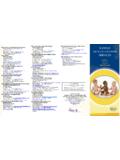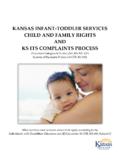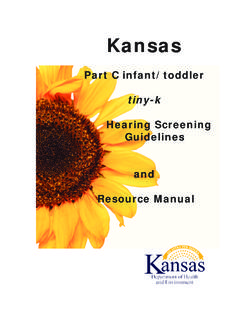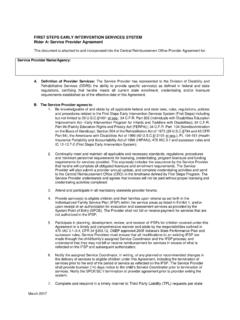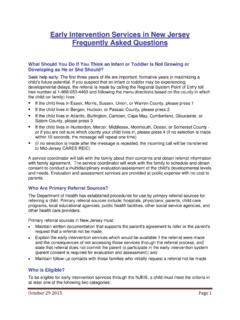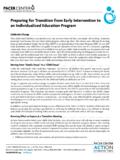Transcription of Individualized Family Service Plan - ksits.org
1 Kansas Infant Toddler services Individual Family Service plan (IFSP). Guidance Document 1. v. TABLE OF CONTENTS. INTRODUCTION ..3. IFSP COVER PAGE ..6. CHILD AND Family INFORMATION 7. IMPORTANT DATES .9. ELIGIBILITY FOR PART C services AND Family Service COORDINATOR INFORMATION .13. SUMMARY OF RELEVANT HEALTH STATUS .15. MY CHILD'S STORY (CHILD'S PRESENT LEVEL OF DEVELOPMENT) .17. Family CONCERNS, RESOURCES, PRIORITIES .21. OTHER services .22. OUTCOMES FOR CHILDREN AND FAMILIES .23. SUMMARY OF services .25. NATURAL ENVIRONMENT JUSTIFICATION .27. IFSP AGREEMENT .28. PART C TRANSITION PLANNING TIMELINES AND PROCEDURES .29. TRANSITION CONFERENCE DOCUMENTATION.
2 31. IFSP REVIEW .33. IFSP REVIEW AGREEMENT .33. APPENDIX .35. 2. v. INTRODUCTION. Kansas Infant Toddler services has created this Individualized Family Service plan (IFSP) Guidance Document to assist local tiny-k programs in completing the IFSP process using the statewide IFSP form. This guidance document promotes the purpose and mission of Kansas Infant Toddler services . PURPOSE: To enhance the development of infants and toddlers with disabilities, to minimize their potential for developmental delays and to recognize the significant brain development that occurs during the child's first three years. To enhance capacity of families to meet the special needs of their infants and toddlers with disabilities through partnerships with families and communities.
3 MISSION: Assure a statewide system of early intervention services Facilitate the coordination of payment for services Enhance quality and improvement in services Encourage expansion of Service opportunities Kansas Infant Toddler services has designed the statewide IFSP with extensive stakeholder input. The statewide IFSP uses the Mission and Key Principles for Providing Early Intervention services in Natural Environments as a guide. In addition, the document is guided by the Division for Early Childhood Recommended Practices. Therefore, the following beliefs are held: Parents are equal members of the IFSP team. The IFSP process is central to the delivery of early intervention supports and services .
4 ifsp outcomes must be functional and based on children's and families' need and Family identified priorities. The team, including parents, decides the supports, services , and specific strategies that are used to meet those outcomes. The whole team not one individual, makes decisions. The IFSP is a dynamic document that changes over time as The IFSP is MORE than the needs of the child and/or Family change. Just Paperwork! The IFSP is MORE than just Paperwork! It is a process that leads It is a process . to quality services ! The IFSP form is a way to document the discussions that occur from intake to exit: Complete the Child and Family Information with the information provided by the Family during the intake process-then review for accuracy with the Family and the team at the IFSP meeting.
5 Complete the My Child's Story with the information provided by the Family using a Family assessment tool. Include information provided by the evaluation team and from the Eligibility for Part C services . section ahead of the meeting then review for accuracy with the Family and the team at the IFSP. meeting. 3. v. The team decides on the child and Family outcomes to be addressed within the context of daily routines and based on information included in the My Child's Story as well as the concerns and priorities of the Family . This information includes the developmental needs of the child. The team decides what supports and services will be provided to enable the child and Family to be successful in making progress towards the outcomes.
6 Transition plan and conference decisions are recorded at the appropriate times. The IFSP is reviewed at least every 6 months and amended as needed. A new IFSP is developed annually. This Guidance Document and the Accompanying IFSP Form: Support effective working relationships between families and early intervention personnel as they promote the development of infants and toddlers;. Promote recommended practices, including services and supports in everyday routines, activities, and places, and evidence based practices that adhere to the primary Service provider approach to teaming;. Provide consistency for meeting regulatory requirements;. Enhance consistent communication regarding expectations among IFSP team members, as well as among provider agencies; and Serve as a reference for ongoing training and professional development.
7 IFSP Updates: Periodically, Kansas Department of Health and Environment (KDHE) Infant-Toddler services (ITS) will update the existing IFSP with policy or other relevant changes. Each time it is updated, the new date is placed in the upper right hand corner. KS ITS avoids changing the statewide IFSP as much as possible but please check the website periodically to make sure you are using the most current version. Notice of significant changes will be alerted via infant toddler services coordinator list serv. For more information regarding writing quality content on your IFSP, please use the criteria on the Quality Indicator Rubric (QIR) which is found at Please contact the Kansas Inservice Training System (KITS) if you need additional assistance in writing quality IFSPs.
8 Each IFSP must be INDIVIDUAIZED. The examples provided can be used to stimulate your thinking and conversations with team members. The examples CANNOT be used as a formula or prescribed way to write that section of the IFSP. 4. v. Linking the IFSP with the Infant-Toddler services Database: Dates and N/A. It is required that data be entered into the ITS Database within 15 business days after the data is gathered. For blanks occurring in the IFSP document, please use N/A when you are completing this information. For dates, use 00/00/0000 for the date boxes if you do not know the date, the date is missing, or you had no reason to record the date. You will not be able to put date values in the web based version as the 00/00/0000 format is not a valid date.
9 The date fields will also not accept N/A. These fields will be blank when printed. Text fields will allow N/A. to be entered. The guidance for each page or major section of the IFSP has been organized in the following manner as applicable: 1. Heading of Each IFSP Page Describes what each page is intended to cover and accomplish. 2. Numbered Line by Line Guidance for Completing Each IFSP Page This line-by-line guidance offers succinct, practical suggestions for completing each numbered item of the page as required. 3. Tips When appropriate, the Tips include examples of questions to ask families and other team members to elicit the required information as well as examples of ways to write these sections of the IFSP.
10 4. Kansas Shape The Kansas shape highlights special considerations and provides example questions that may be used with families or other team members. Additional examples illustrate how this section of the IFSP may be written. 5. Mouse Icon . The mouse icon indicates when information about the web based IFSP is different from the IFSP Word document. 5. v. IFSP COVER PAGE. A page has been added so each local tiny-k program can design a personalized cover page. Child's name, date of birth, and IFSP date, as well as, the name of your local network is included on the cover page. You may also include a photo of the child or Family as desired. (For the purpose of illustration, a fictional child has been created - Christopher Lee Horton.)
